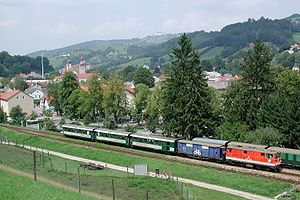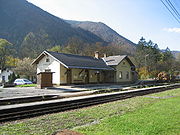
Ybbstalbahn
Encyclopedia

Lower Austria
Lower Austria is the northeasternmost state of the nine states in Austria. The capital of Lower Austria since 1986 is Sankt Pölten, the most recently designated capital town in Austria. The capital of Lower Austria had formerly been Vienna, even though Vienna is not officially part of Lower Austria...
n Mostviertel
Mostviertel
Mostviertel is the southwestern quarter of the four quarters of Lower Austria . It is bordered on the north by the Danube and to the south and west by the state borders of Styria and Upper Austria respectively...
.
The original route follows the valley of the river Ybbs
Ybbs
Ybbs is a river in Lower Austria, and in Austria also the common short form to designate the little town Ybbs an der Donau.Its source is located on the Zellerrain Pass near Mariazell...
from Waidhofen an der Ybbs
Waidhofen an der Ybbs
Waidhofen an der Ybbs is an independent city in the Austrian state of Lower Austria. The city had a population of 11,662 as of the 2001 census...
up to the market town of Lunz am See
Lunz am See
Lunz am See is a municipality in the district of Scheibbs, Lower Austria, Austria.Since May 2007 Lunz am See is the home of the "Wasser Cluster Lunz"....
, with a branchline to the town of Ybbsitz
Ybbsitz
Ybbsitz is a town in the district of Amstetten in Lower Austria in Austria....
. The original route extended from Lunz am See to Kienberg Gaming, and is currently operated as a heritage railway
Heritage railway
thumb|right|the Historical [[Khyber train safari|Khyber Railway]] goes through the [[Khyber Pass]], [[Pakistan]]A heritage railway , preserved railway , tourist railway , or tourist railroad is a railway that is run as a tourist attraction, in some cases by volunteers, and...
under the name Ybbsthalbahn-Bergstrecke (mountain line).
Waidhofen am der Ybbs - Lunz am See
The Ybbstalbahn starts from the narrow-gauge railway platform opposite the main standard gauge station at Waidhofen am der Ybbs, where the workshops and freight transhipment facilities are also located. The railway first serves several halts in the city of Waidhofen, which primarily serve suburban traffic, until it comes to the station at Gstadt at the 6 km mark, which is the junction for the branch line to Ybbsitz.
Opponitz
Opponitz is a town in the district of Amstetten in Lower Austria in Austria....
, the location of the only tunnel of the Ybbstalbahn, and then after 25 km Hollenstein an der Ybbs
Hollenstein an der Ybbs
Hollenstein an der Ybbs is a town in the district of Amstetten in Lower Austria in Austria.- Literature :Willibald Bissenberger et al.: Hollenstein an der Ybbs. Ein Dorf im Wandel von etwas mehr als hundert Jahren..., Waidhofen an der Ybbs 2003, ISBN 3-200-00050-3.- External links :*...
(station Großhollenstein). This section from here gains altitude, as it follows the valley of the upper Ybbs.
This section serves mainly smaller stops, which are used mainly by hikers during the summer, only Sankt Georgen am Reith
Sankt Georgen am Reith
Sankt Georgen am Reith is a town in the district of Amstetten in Lower Austria in Austria.-References:...
providing much local passenger traffic. At kilometre 44 is the tourist town of Göstling
Gostling
Gostling may refer to:* John Gostling English singer* Göstling an der Ybbs...
in the Scheibbs
Scheibbs
Scheibbs is a town in Austria. It is in the Scheibbs district of Lower Austria.Scheibbs is the birthplace of West Bromwich Albion football player Paul Scharner....
district, and a further nine kilometres the present terminus of Lunz am See.
The line continued over the Pfaffenschlag pass to Kienberg Gaming where it connected to the standard gauge Erlauftalbahn to the district capital Scheibbs
Scheibbs
Scheibbs is a town in Austria. It is in the Scheibbs district of Lower Austria.Scheibbs is the birthplace of West Bromwich Albion football player Paul Scharner....
. This section was closed in May 1988, and has operated since 1990 as a heritage railway.
A gauge forestry railway up the valley of the Ois terminated at Lunz am See station until it closed in the 1970s.
Gstadt - Ybbsitz
Gstadt station is the junction for the branch line, the line branching off the main route and crossing the Ybbs on a steel girder bridge. The line, which follows the valley of the Kleine Ybbs (Little Ybbs), serves several small stops and ends after six kilometers in the market town of Ybbsitz. The line crosses several level crossingLevel crossing
A level crossing occurs where a railway line is intersected by a road or path onone level, without recourse to a bridge or tunnel. It is a type of at-grade intersection. The term also applies when a light rail line with separate right-of-way or reserved track crosses a road in the same fashion...
s, resulting in conflict with automobile traffic.
Gaming - Lunz am See (preserved railway)

Shortly after leaving Kienberg-Gaming station the railway crosses a main road, and a little later, on a steel framework bridge, the Pockaubach and the road to Gresten
Gresten
Gresten is a municipality in the district of Scheibbs in Lower Austria, Austria....
. The alignment follows a steep wooded mountain saddle-back up to the summit of the Pfaffenschlag, at which first the stop, Gaming, is reached. The scenery opens up here to offer a beautiful panorama view over the region and the Kartause Gaming, after which the railway enters a steep rocky section in dense forest, and runs through many deep cuttings. In this section are the two landmarks of the "mountain line", two steel trestle viaducts, a bridge type otherwise only used in Austria on the Stubaitalbahn. The maximum grade on this section of the Ybbstalbahn is 3.44 % (1:29), which is the steepest gradient of any Austrian narrow-gauge railway with a track gauge of 760 mm.
The highest point the railway, 699 m, is reached at Pfaffenschlag, which also highest point of the parallel pass road. At this station the steam engines replenish their water supply, then the railway follows the valley of the Bodingbach. The tracks run through several deep rock cuttings, and in particularly steep area solid retaining walls are used. The railway soon reaches the first houses of the summer-resort Lunz am See and runs through a forest of wood-apples
Malus sylvestris
Malus sylvestris, the European wild apple, is a species of Malus , native to Europe from as far south as Spain, Italy and Greece to as far north as Scandinavia and Russia. Its scientific name means "forest apple", and the truly wild tree has thorns.In the past, M. sylvestris was thought to be an...
. The railway then runs partially close area between the roofs of houses and a cliff. After crossing the Bodingbach the railway reaches the station of Lunz am See, which it uses in conjunction with the section of the Ybbstalbahn still run by the ÖBB.
History
There were plans in 1870 to build a railway up the valley of the Ybbs to Kienberg Gaming. The collapse of the stock market of Vienna in 1873 brought a sudden end to this project. In the 1880s representatives of the Ybbstal again looked at building a secondary line, however only in 1893 did negotiations with the government Ministries begin. On 26 December of the same year a law was passed for the building of the Ybbstalbahn. Consequently a decree of the Ministry of the Interior was given on the 11 September 1895 for the establishment of a corporation with the capital investment of 1,612,000 guldens.The turning of the first sod for the initial section from Waidhofen to Gross Hollenstein took place at Waidhofen on 1 June 1895. The opening of this section took place on 15 July 1896. Three years later, on 15 May 1898, the second section from Gross Hollenstein to Lunz am See was opened. The section from Lunz am See - the so-called "Bergstrecke" - to Kienberg-Gaming, the most difficult section to construct, was opened later that year, on 12 November. Thus the entire 71 km route was constructed over a period of only 3 years.
With the building of the railway, the practice of rafting timber
Timber rafting
Timber rafting is a log transportation method in which logs are tied together into rafts and drifted or pulled across a water body or down a flatter river. It is arguably the second cheapest method of transportation of timber, next after log driving...
down the river ceased as it was unable to compete. The iron and steel processing industry was however tied up better with the ore mines on the Erzberg mountain and this industry prospered.
Closure of the mountain line and re-opening as a museum railway
The heavily-graded section of the Ybbstalbahn known as the "Bergstrecke", with a length of 17.5 kilometers, connected the upper Ybbstal around Lunz am See and Göstling an der Ybbs with the Erlauftal, where it connected to the standard gauge line to the town of Scheibbs. The drift of passengers to buses and private cars on the faster road connection over the Grubberg pass road, as well as the transit of almost all goods traffic through Waidhofen led to a continuous decline in income. These developments led finally in May 1988 to the closure of this section of the railway.The Austrian Society for Local Railways (ÖGLB) already successfully operated the Höllentalbahn
Höllentalbahn (Niederösterreich)
The Lower Austrian Höllental Railway is a narrow gauge electric railway with a track gauge of , which runs from the Austrian Federal Railways station of Payerbach Reichenau on the Semmering Railway for approximately five kilometres through the market town of Reichenau an der Rax to Hirschwang.-...
as a museum railway at this time, the operating company being the NÖLB (Niederösterreich local railways). The NÖLB leased this section from ÖBB and commenced operation as a museum railway in 1990 under the name "Ötscherland Express". Later the railway was renamed the "Ybbsthalbahn-Bergstrecke" (Ybbsthalbahn mountain line).

